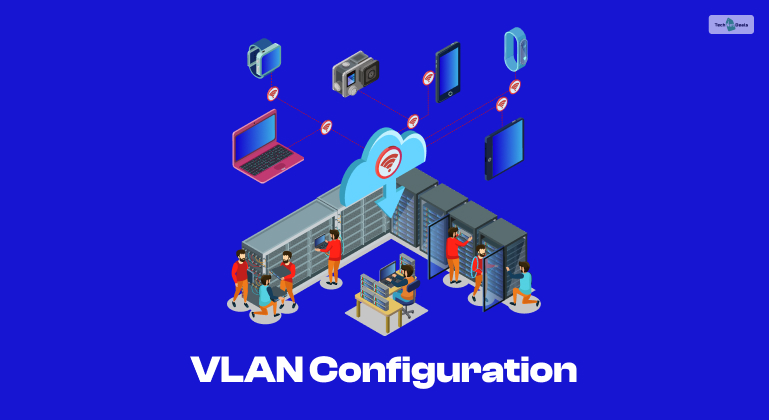
If you have ever worked with a network, you might have heard of the term VLAN. But what is a VLAN configuration, and how does it work? And why is it essential for your network configuration?
In this post, we will answer these questions and explain a VLAN configuration in simple terms. We will also show you how to set up VLAN on your network devices, such as routers, switches, and computers. Let’s get started!
What Is A VLAN Configuration?
VLAN stands for Virtual Local Area Network, which is a logical subdivision of a physical network. A VLAN allows you to group network devices that share the same characteristics, such as location, function, security, or performance, into separate segments, regardless of their physical connection or location.
A VLAN also allows you to isolate network traffic within each segment, such as broadcast, multicast, or unicast, and control the communication between different segments.
What Are The Advantages Of Using A VLAN Configuration?
The main advantages of using a VLAN configuration are:
1. Improved Network Performance
By dividing a network into smaller segments, VLAN reduces network congestion and collisions and improves bandwidth utilization and efficiency.
VLAN reduces the broadcast domain, which is the area where broadcast messages are sent and received by all network devices. In addition, it also limits the impact of broadcast storms, which are excessive broadcast messages that can cause network slowdowns or failures.
2. Enhanced Network Security
By separating network devices into different segments, VLAN increases network security and privacy and prevents unauthorized access or attacks.
Therefore, VLAN also allows you to apply different security policies and rules to each segment and encrypt the data transmission between different segments.
3. Increased Network Flexibility And Scalability
By creating logical segments, VLAN allows you to easily add, move, or change network devices without affecting the physical network topology or configuration.
Moreover, VLAN also allows you to extend your network across multiple locations, such as different buildings, floors, or rooms, and connect them through a single cable or wireless link.
How Does A VLAN Configuration Work?
The VLAN configuration process involves two main components: VLAN ID and VLAN Tag. Here is how they work:
1. VLAN ID
A VLAN ID is a numerical identifier that assigns a network device to a specific VLAN segment. A VLAN ID can range from 1 to 4094, and each VLAN segment must have a unique VLAN ID.
For example, you can assign VLAN ID 10 to the network devices that belong to the sales department and VLAN ID 20 to the network devices that belong to the marketing department.
2. VLAN Tag
A VLAN Tag is a 4-byte header added to the Ethernet frame, which is the data packet transmitted between network devices. It contains the VLAN ID and other information, such as the priority and type of the Ethernet frame.
Therefore, a VLAN Tag allows the network devices to identify and process the Ethernet frame according to its VLAN ID and other information.
For example, when a network device receives an Ethernet frame with VLAN Tag 10, it knows it belongs to the sales department and forwards it to the appropriate network device.
How To Set Up A VLAN?
Depending on your network setup and preferences, you might need to set up a VLAN configuration on your network devices. Here are some common scenarios and steps to set up a VLAN configuration:
Step 1: Create VLAN Segments On Your Switch
If you want to create VLAN segments on your switch, which is a network device that connects multiple network devices, such as computers, printers, or servers, you need to access your switch’s web interface and look for the option to create VLAN.
For example, on a Cisco switch, you can go to http://192.168.1.1/ > Login > VLAN > VLAN Management > Create VLAN. You then need to enter each VLAN segment’s VLAN ID, name, and description and click Apply.
Step 2: Assign VLAN IDs to Your Switch Ports
If you want to assign VLAN IDs to your switch ports, which are the physical interfaces that connect your switch to other network devices, you need to access your switch’s web interface and look for the option to assign VLAN.
For example, on a Cisco switch, you can go to http://192.168.1.1/ > Login > VLAN > VLAN Management > Port to VLAN. You then need to select the switch port, enter the VLAN ID you want to assign, and click Apply.
Step 3: Enable VLAN Tagging On Your Router
Suppose you want to enable VLAN tagging on your router, a network device connecting multiple networks, like your local network. In that case, you need to access your router’s web interface and look for the option to enable VLAN.
For example, on a Linksys router, you can go to http://192.168.1.1/ > Login > Setup > Advanced Routing > VLAN. You must enable the VLAN option, enter the VLAN ID, name, and priority for each VLAN segment, and click on Save Settings.
Step 4: Configure VLAN Configuration On Your Computer
Suppose you want to configure VLAN configuration on your computer, which is a network device that connects to your network. In that case, you need to access your computer’s network settings and look for the option to configure VLAN.
For example, on Windows 10, you can go to Settings > Network & Internet > Wi-Fi or Ethernet > Change adapter options > Right-click on your network adapter > Properties > Configure > Advanced > VLAN ID. You then need to enter the VLAN ID that you want to use for your computer and click on OK.
How To Troubleshoot VLAN?
Sometimes, you might encounter some problems with your VLAN configuration, such as:
1. VLAN Is Not Working
Suppose your network devices are not able to communicate with each other within or across VLAN segments. Therefore, you might see an error message, such as “Network unreachable” or “No Internet access.” To fix this, you can try the following steps:
- Check if your network devices are connected and powered on properly.
- Ensure your network devices support VLAN and are configured to enable VLAN.
- Check if your network devices have the correct VLAN ID and VLAN Tag assigned to them.
- Ensure your network devices have the correct IP address, subnet mask, default gateway, and DNS server assigned to them.
- Ensure your network devices have valid security and firewall settings to allow VLAN traffic.
- Check if your network cable or Wi-Fi connection is working correctly.
- Restart your network devices.
2. VLAN Has Performance Issues
If your network devices experience slow or intermittent network performance within or across VLAN segments, you might see an error message, such as “Network lag” or “Connection timeout.”
To fix this, you can try the following steps:
- Check if your network devices are overloaded or congested with network traffic.
- Ensure your network devices have the correct VLAN priority and quality of service settings to prioritize VLAN traffic.
- Check if your network devices have the correct VLAN trunking and routing settings to optimize VLAN traffic.
- Ensure your network devices have the correct VLAN filtering and pruning settings to reduce VLAN traffic.
- Ensure your network devices have the latest firmware and software updates to improve VLAN performance.
- Optimize your network devices’ settings and configuration to suit your network needs and preferences.
Conclusion
To use a VLAN configuration, you must have network devices supporting VLAN, such as routers, switches, and computers. You must also configure your network devices to enable VLAN and assign VLAN IDs and VLAN Tags to them.
If you have any questions or suggestions, feel free to leave a comment below. And don’t forget to follow our website for more tips and tricks on mastering network configuration. Happy networking!
More Resources:
![What Is A VLAN Configuration? How To Set Up VLAN? [2024 Guide]](https://www.technetdeals.com/wp-content/uploads/thumbs_dir/Phone-Psychic-Experience-qi6ttmylh175nyw6hx5mexpplmwown0lcfambg5tfg.webp)
![What Is A VLAN Configuration? How To Set Up VLAN? [2024 Guide]](https://www.technetdeals.com/wp-content/uploads/thumbs_dir/VPN-Troubleshooting-qic57i2gpcwiqqzcj3p1zax2rjn7v1ary33dl4hovw.jpg)




